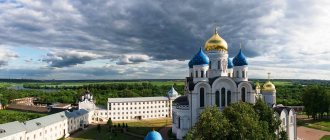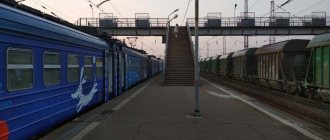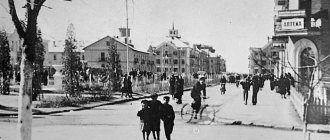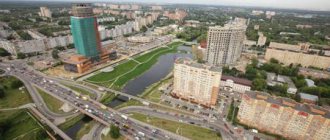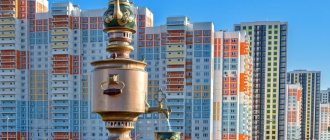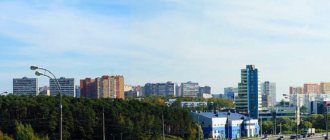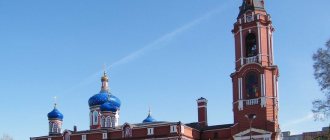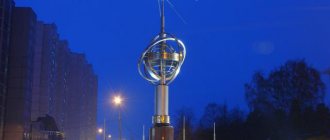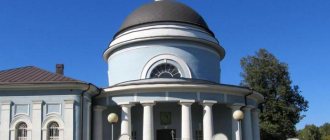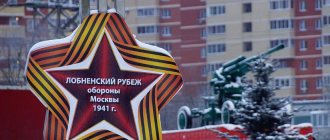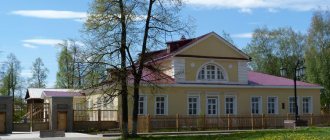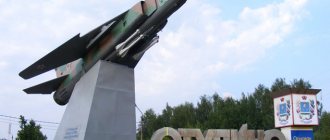Pokrovsky Convent
If not many people know Khotkovo, then most Orthodox believers are familiar with the Intercession Monastery. But the address of its location is Khotkovo, Moscow region. Today the exact date of when the monastery was founded is unknown. This is considered to be the first chronicle mention of him. And this is 1308.
From a small monastery consisting of a church and several wooden buildings, over the years, by the mid-19th century, the Intercession Monastery turned not only into a significant monastic monastery with numerous novices, but also into a large architectural ensemble.
During the years of Soviet power, the monastery was closed. Many of its buildings were seriously damaged because they were used for other purposes.
An excerpt characterizing the urban settlement of Khotkovo
“Yes, I’m with you,” said Pierre, looking around him and looking for his guard with his eyes. Here, only for the first time, Pierre saw the wounded, wandering on foot and carried on stretchers. In the same meadow with fragrant rows of hay through which he drove yesterday, across the rows, his head awkwardly turned, one soldier lay motionless with a fallen shako. - Why wasn’t this raised? - Pierre began; but, seeing the stern face of the adjutant, looking back in the same direction, he fell silent. Pierre did not find his guard and, together with his adjutant, drove down the ravine to the Raevsky mound. Pierre's horse lagged behind the adjutant and shook him evenly. “Apparently you’re not used to riding a horse, Count?” – asked the adjutant. “No, nothing, but she’s jumping around a lot,” Pierre said in bewilderment. “Eh!.. yes, she’s wounded,” said the adjutant, “right front, above the knee.” Must be a bullet. Congratulations, Count,” he said, “le bapteme de feu [baptism by fire]. Having driven through the smoke through the sixth corps, behind the artillery, which, pushed forward, was firing, deafening with its shots, they arrived at a small forest. The forest was cool, quiet and smelled of autumn. Pierre and the adjutant dismounted from their horses and entered the mountain on foot. - Is the general here? – asked the adjutant, approaching the mound. “We were there now, let’s go here,” they answered him, pointing to the right. The adjutant looked back at Pierre, as if not knowing what to do with him now. “Don’t worry,” said Pierre. – I’ll go to the mound, okay? - Yes, go, you can see everything from there and it’s not so dangerous. And I'll pick you up. Pierre went to the battery, and the adjutant went further. They did not see each other again, and much later Pierre learned that this adjutant’s arm was torn off that day. The mound that Pierre entered was the famous one (later known among the Russians under the name of the kurgan battery, or Raevsky’s battery, and among the French under the name la grande redoute, la fatale redoute, la redoute du center [the great redoubt, the fatal redoubt, the central redoubt ] a place around which tens of thousands of people were positioned and which the French considered the most important point of the position. This redoubt consisted of a mound on which ditches were dug on three sides. In a place dug in by ditches there were ten firing cannons, protruding into the opening of the ramparts. In line with the mound. there were cannons on both sides, also firing incessantly. A little behind the cannons stood infantry troops. Entering this mound, Pierre did not think that this place, dug in with small ditches, where several cannons stood and fired, was the most important place in the battle. Pierre ", on the contrary, it seemed that this place (precisely because he was on it) was one of the most insignificant places of the battle. Entering the mound, Pierre sat down at the end of the ditch surrounding the battery, and with an unconsciously joyful smile looked at what was happening Around him. From time to time, Pierre still stood up with the same smile and, trying not to disturb the soldiers who were loading and rolling guns, constantly running past him with bags and charges, walked around the battery. The guns from this battery fired continuously one after another, deafening with their sounds and covering the entire area with gunpowder smoke. In contrast to the creepiness that was felt between the infantry soldiers of the cover, here, on the battery, where a small number of people busy with work are white limited, separated from others by a ditch - here one felt the same and common to everyone, as if a family revival. The appearance of the non-military figure of Pierre in a white hat initially struck these people unpleasantly. The soldiers, passing by him, glanced sideways at his figure in surprise and even fear. The senior artillery officer, a tall, long-legged, pockmarked man, as if to watch the action of the last gun, approached Pierre and looked at him curiously. A young, round-faced officer, still a complete child, apparently just released from the corps, very diligently disposing of the two guns entrusted to him, addressed Pierre sternly. “Mister, let me ask you to leave the road,” he told him, “it’s not allowed here.” The soldiers shook their heads disapprovingly, looking at Pierre. But when everyone was convinced that this man in a white hat not only did nothing wrong, but either sat quietly on the slope of the rampart, or with a timid smile, courteously avoiding the soldiers, walked along the battery under gunfire as calmly as along the boulevard, then Little by little, the feeling of hostile bewilderment towards him began to turn into affectionate and playful sympathy, similar to that which soldiers have for their animals: dogs, roosters, goats and in general animals living with military commands. These soldiers immediately mentally accepted Pierre into their family, appropriated them and gave him a nickname. “Our master” they nicknamed him and laughed affectionately about him among themselves. One cannonball exploded into the ground two steps away from Pierre. He, cleaning the soil sprinkled with the cannonball from his dress, looked around him with a smile. - And why aren’t you afraid, master, really! - the red-faced, broad soldier turned to Pierre, baring his strong white teeth. -Are you afraid? asked Pierre. - How then? - answered the soldier. - After all, she will not have mercy. She will smack and her guts will be out. “You can’t help but be afraid,” he said, laughing. Several soldiers with cheerful and affectionate faces stopped next to Pierre. It was as if they did not expect him to speak like everyone else, and this discovery delighted them. - Our business is soldierly. But master, it’s so amazing. That's it master! - In places! - the young officer shouted at the soldiers gathered around Pierre. This young officer, apparently, was fulfilling his position for the first or second time and therefore treated both the soldiers and the commander with particular clarity and formality. The rolling fire of cannons and rifles intensified throughout the entire field, especially to the left, where Bagration’s flashes were, but because of the smoke of the shots, it was impossible to see almost anything from the place where Pierre was. Moreover, observing the seemingly family (separated from all others) circle of people who were on the battery absorbed all of Pierre’s attention. His first unconscious joyful excitement, produced by the sight and sounds of the battlefield, was now replaced, especially after the sight of this lonely soldier lying in the meadow, by another feeling. Now sitting on the slope of the ditch, he observed the faces surrounding him. By ten o'clock twenty people had already been carried away from the battery; two guns were broken, shells hit the battery more and more often, and long-range bullets flew in, buzzing and whistling. But the people who were at the battery did not seem to notice this; Cheerful talk and jokes were heard from all sides. - Chinenka! - the soldier shouted at the approaching grenade flying with a whistle. - Not here! To the infantry! – another added with laughter, noticing that the grenade flew over and hit the covering ranks. - What, friend? - another soldier laughed at the man who crouched under the flying cannonball. Several soldiers gathered at the rampart, looking at what was happening ahead. “And they took off the chain, you see, they went back,” they said, pointing across the shaft. “Mind your job,” the old non-commissioned officer shouted at them. “We’ve gone back, so it’s time to go back.” - And the non-commissioned officer, taking one of the soldiers by the shoulder, pushed him with his knee. There was laughter. - Roll towards the fifth gun! - they shouted from one side. “At once, more amicably, in the burlatsky style,” the cheerful cries of those changing the gun were heard. “Oh, I almost knocked off our master’s hat,” the red-faced joker laughed at Pierre, showing his teeth. “Eh, clumsy,” he added reproachfully to the cannonball that hit the wheel and the man’s leg. - Come on, you foxes! - another laughed at the bending militiamen entering the battery behind the wounded man. - Isn’t the porridge tasty? Oh, the crows, they slaughtered! - they shouted at the militia, who hesitated in front of the soldier with a severed leg. “That’s something, little guy,” they mimicked the men. – They don’t like passion. Pierre noticed how after each cannonball that hit, after each loss, the general revival flared up more and more. As if from an approaching thundercloud, more and more often, lighter and brighter, lightning of a hidden, flaring fire flashed on the faces of all these people (as if in rebuff to what was happening). Pierre did not look forward to the battlefield and was not interested in knowing what was happening there: he was completely absorbed in the contemplation of this increasingly flaring fire, which in the same way (he felt) was flaring up in his soul. At ten o'clock the infantry soldiers who were in front of the battery in the bushes and along the Kamenka River retreated. From the battery it was visible how they ran back past it, carrying the wounded on their guns. Some general with his retinue entered the mound and, after talking with the colonel, looked angrily at Pierre, went down again, ordering the infantry cover stationed behind the battery to lie down so as to be less exposed to shots. Following this, a drum and command shouts were heard in the ranks of the infantry, to the right of the battery, and from the battery it was visible how the ranks of the infantry moved forward. Pierre looked through the shaft. One face in particular caught his eye. It was an officer who, with a pale young face, walked backwards, carrying a lowered sword, and looked around uneasily.
Monastery today
In 1992, the monastery began its new revival, because it was again transferred to the Orthodox Church. The buildings of the monastery were also restored.
The most ancient revived object on the territory of the monastery was the Holy Gate with the Church of the Baptist. It was built in 1799. Another of the oldest surviving buildings of the Khotkov Monastery is the Intercession Cathedral.
With its architecture, it is an example of a five-domed temple that was built in the era of classicism. Today it is the main decoration of the monastery. In 2011, the cathedral was re-painted and a new dome was erected over it.
Now, in addition to the cathedral in honor of the Intercession of the Most Holy Theotokos, the monastery has the St. Nicholas Cathedral, the Gate Church of St. Mitrophan of Voronezh, the three-part Holy Gate with the Church of the Nativity of St. John the Baptist built above it, and many other buildings. Nuns and novices live in the monastery. There is an orphanage, a Sunday school, an icon-painting and sewing workshop, and a subsidiary farm.
Pilgrims who go to the Trinity-Sergius Lavra always visit the monastery in Khotkovo (Moscow region) to venerate the relics of Cyril and Mary.
Notes
- ↑ 123
www.gks.ru/free_doc/doc_2016/bul_dr/mun_obr2016.rar Population of the Russian Federation by municipalities as of January 1, 2021 - ↑ 12
[adm.khotkovo.ru/about/the_head_of_the_urban_settlement_hotkovo/ Head of the urban settlement // Official website of the urban settlement] - ↑ 12345678910
[vesposad.ru/knigi2.php?id_kn=1&id_pgl=39&id_gl=16# Khotkovo urban settlement]. Portal of Sergiev Posad. Retrieved January 6, 2012. [www.webcitation.org/64UIQ6mZc Archived from the original on January 6, 2012]. - [mosobl.elcode.ru/doc.asp?ID=3342&PSC=1&PT=1&Page=4=2 Law of the Moscow Region dated February 28, 2005 No. 60/2005-OZ “On the status and boundaries of the Sergiev Posad municipal district and newly formed in its composition of municipal formations" ( original edition dated February 28, 2005
)], [www.reforma-mo.ru/userdata/142.doc] (.doc) - [www.ramgeo.ru/files/docs/resolutions/156_pg.doc Resolution of the Governor of the Moscow Region dated November 29, 2006 No. 156-PG “On the exclusion of rural districts from the records of administrative-territorial and territorial units of the Moscow Region”] (.doc )
- ↑ 1234567891011121314151617181920212223242526272829
[www.msko.gks.ru/wps/wcm/connect/rosstat_ts/msko/resources/e40105804129853eb81eff367ccd0f13/3+%D1%82%D0%BE%D0%BC.rar The size of the rural population and its distribution in the Moscow region ( results of the 2010 All-Russian Population Census). Volume III] (DOC+RAR). M.: Territorial body of the Federal State Statistics Service for the Moscow Region (2013). Retrieved October 20, 2013. [www.webcitation.org/6KVSB8BfU Archived from the original on October 20, 2013]. - [www.spr.ru/sergiev-posad-i-sergievo-posadskiy-rayon/administratsiya-gorodskogo-poseleniya-hotkovo.html Contacts of the administration of the urban settlement of Khotkovo // spr.ru]
- [msu-mo.ru/userdata/docs/abc_np_03_08_06.zip Alphabetical list of settlements of municipal districts of the Moscow region as of January 1, 2006] (RTF+ZIP). Development of local self-government in the Moscow region. Retrieved February 4, 2013. [www.webcitation.org/64cNVl25K Archived from the original on January 11, 2012].
- [www.alppp.ru/law/konstitucionnyj-stroj/naselenie/11/postanovlenie-pravitelstva-mo-ot-20-08-2007—61530.html Decree of the Government of the Moscow Region dated August 20, 2007 No. 615/30 “On indicators of the estimated number population living in urban and rural settlements of the Moscow region as of January 1, 2007"]. Retrieved September 3, 2013. [www.webcitation.org/6JM8tTlpW Archived from the original on September 3, 2013].
- [bestpravo.ru/moskovskaya/iw-dokumenty/w5v.htm Resolution of the Government of the Moscow Region dated July 2, 2008 No. 519/24 “On the indicators of the estimated population living in urban and rural settlements of the Moscow Region as of January 1, 2008”] . Retrieved September 3, 2013. [www.webcitation.org/6JMTRJwPz Archived from the original on September 3, 2013].
- [www.alppp.ru/law/konstitucionnyj-stroj/naselenie/11/postanovlenie-pravitelstva-mo-ot-29-06-2009—51825.html Resolution of the Moscow Region Government dated 09.09.2009 N 730/37 “On the indicators of the calculated of the population living in urban and rural settlements of the Moscow region as of January 1, 2009"]. Retrieved September 3, 2013. [www.webcitation.org/6JM3Z5DUo Archived from the original on September 3, 2013].
- [www.gks.ru/free_doc/new_site/perepis2010/croc/Documents/Vol1/pub-01-11.xlsx Population Census 2010. Population of Russia, federal districts, constituent entities of the Russian Federation, city districts, municipal districts, urban and rural settlements] (Russian). Federal State Statistics Service. Retrieved December 16, 2013. [www.webcitation.org/6GDBk0rPa Archived from the original on April 28, 2013].
- www.gks.ru/dbscripts/munst/munst46/DBInet.cgi?pl=8112027 Moscow region. Estimated resident population as of January 1, 2009-2016
- [www.gks.ru/free_doc/doc_2012/bul_dr/mun_obr2012.rar Population of the Russian Federation by municipalities. Table 35. Estimated resident population as of January 1, 2012]. Retrieved May 31, 2014. [www.webcitation.org/6PyOWbdMc Archived from the original on May 31, 2014].
- [www.gks.ru/free_doc/doc_2013/bul_dr/mun_obr2013.rar Population of the Russian Federation by municipalities as of January 1, 2013. - M.: Federal State Statistics Service Rosstat, 2013. - 528 p. (Table 33. Population of urban districts, municipal districts, urban and rural settlements, urban settlements, rural settlements)]. Retrieved November 16, 2013. [www.webcitation.org/6LAdCWSxH Archived from the original on November 16, 2013].
- [www.gks.ru/free_doc/doc_2014/bul_dr/mun_obr2014.rar Table 33. Population of the Russian Federation by municipalities as of January 1, 2014]. Retrieved August 2, 2014. [www.webcitation.org/6RWqP50QK Archived from the original on August 2, 2014].
- [www.gks.ru/free_doc/doc_2015/bul_dr/mun_obr2015.rar Population of the Russian Federation by municipalities as of January 1, 2015]. Retrieved August 6, 2015. [www.webcitation.org/6aaNzOlFO Archived from the original on August 6, 2015].
Either a village or a farm
Before 1917, such a settlement as Khotkovo (Moscow region) did not exist at all. In those days, many small villages and hamlets were scattered throughout the Morozov and Mitinsk volosts. However, after the revolution, Khotkovo began to grow. A Council of Workers' Deputies was even created there, because many factories and factories operated in the vicinity. The land was nationalized and most of it was transferred to the peasants.
Soon Khotkovo became the center of the volost, an urban-type settlement, where a copper foundry, weaving factories, and artels operated. Khotkovo became a city of regional subordination in 1949.
Population
| Population | ||||||
| 2006[8] | 2007[9] | 2008[10] | 2009[11] | 2010[12] | 2011[13] | 2012[14] |
| 24 283 | ↘23 753 | ↘23 590 | ↘23 395 | ↗24 889 | ↗24 932 | →24 932 |
| 2013[15] | 2014[16] | 2015[17] | 2016[1] | |||
| ↗25 198 | ↘25 134 | ↗25 157 | ↘25 032 | |||
- In 1899, approximately 3,000 people lived on the territory of the current urban settlement of Khotkovo[3].
- In 1918-1919, most of the Mitinskaya and parts of the Morozovskaya, Bogoslovskaya and Ozeretskaya volosts of the Dmitrov district were included in the newly formed Khotkovskaya volost of the Dmitrov district[3].
- In 1921, the volost was included in the new Sergievsky district[3].
- In 1927, about 7,000 people lived on the territory of the modern settlement[3].
- In 2007 - 23,825 people, including 20,342 people in the city of Khotkovo.[3]
Khotkovo, Moscow region: attractions
Without a doubt, the main attraction of the city is the Intercession Khotkov Monastery, on the territory of which, by the way, there is a museum.
The Church of St. Alexis the Man of God, or, as it is also called, the Gorbunov Church, also attracts Orthodox Christians and tourists. It was built in the village of Gorbunovo, which eventually became part of the city. The stone church, which has survived to this day, was built by the architect Ivan Safonov. It was consecrated in 1863.
The local history museum of Khotkovo, Moscow region is also of interest.
Not far from the city there is the Abramtsevo museum-estate, which for some time was the property of the Russian writer Sergei Aksakov. The estate was visited by I.S. Turgenev, N.V. Gogol and other creative people of that time. When she passed on to the wealthy industrialist Savva Mamontov, her artistic life did not freeze. After all, this man was also a philanthropist, an art lover. The Abramtsevo art circle was created, which brought together famous artists, musicians, and poets.
Having visited Khotkovo (Moscow region), a photo should be taken as a souvenir from the village of Radonezh, where Sergius of Radonezh, who is the founder of the Trinity Lavra of St. Sergius, spent his childhood. What attracts attention there is the Church of the Transfiguration, a kind of cross in front of it, a very interesting monument to Sergius of Radonezh, erected in 1989, the ramparts and the source of holy water, where the fonts were built.
For your information, the Church of the Transfiguration is the metochion of the Trinity-Sergius Lavra.
Composition of the urban settlement
| The urban settlement includes 30 settlements | |||
| № | Locality | Type of settlement | Population |
| 1 | Abramtsevo | village | ↘209[6] |
| 2 | Antipino | village | ↘10[6] |
| 3 | Arkhanovo | village | ↘14[6] |
| 4 | Okhtyrka | village | ↘73[6] |
| 5 | Bykovo | village | ↗38[6] |
| 6 | Gavrilkovo | village | ↘41[6] |
| 7 | Glebovo | village | ↘17[6] |
| 8 | Zheltikovo | village station | ↘107[6] |
| 9 | Bugs | village | ↘1484[6] |
| 10 | Zolotilovo | village | ↗132[6] |
| 11 | Koroskovo | village | ↗28[6] |
| 12 | Kudrino | village | ↗22[6] |
| 13 | Matryonkas | village | →2[6] |
| 14 | Mashino | village | ↗30[6] |
| 15 | Machine operators | village | ↘56[6] |
| 16 | Mitino | farm | ↘54[6] |
| 17 | Morozovo | village | ↘149[6] |
| 18 | Whorls | village | →28[6] |
| 19 | Novopodushkino | village | ↗95[6] |
| 20 | Novosyolki | village | ↗15[6] |
| 21 | ORGRES | village | ↘245[6] |
| 22 | Podushkino | village | ↗38[6] |
| 23 | Repikhovo | village | ↗162[6] |
| 24 | Repikhovo | village | ↘210[6] |
| 25 | Stroikovo | village | ↘3[6] |
| 26 | Teshilova | village | ↘11[6] |
| 27 | Corners | village | ↘9[6] |
| 28 | Filimonovo | village | ↗32[6] |
| 29 | Khotkovo | city, administrative center | ↘21 538[1] |
| 30 | Shapilovo | village | ↗70[6] |
Khotkovo, Moscow region: how to get there
This city of regional subordination is located 60 kilometers from Moscow in the Sergiev Posad district (11 kilometers from Sergiev Posad). The river on which it stands is called Pazha, which refers to the Klyazma basin. The population of the city is more than 20 thousand people. Among the enterprises in Khotkovo, the most famous and significant are OJSC Elektroizolit and the Central Research Institute of Special Engineering.
There is a railway station in Khotkovo, so you can get to it along the Moscow - Yaroslavl line.
By car you need to go along the Yaroslavl highway. The trip promises to be interesting.
Political and social life in the city in 2010
At the end of October 2010, a native of the city, Pavel Kapralov, was killed in Khotkovo by migrant workers. On November 4, a spontaneous demonstration of city residents took place, demanding that migrant workers be “expelled” from the city and blocking the main street. According to the Khotkovo Department of Internal Affairs, the situation was aggravated by the arrival of nationalists from the “Slavic Union” and DPNI. On November 5, all migrant workers left the city.
Member of the Public Chamber of Russia Alexander Brod, chairman of the public organization “Civil Forces” Valery Ivankovsky and head of the Federation of Migrants of Russia Majumder Amin came to the city to assess the situation. Alexander Brod said that the situation in the city is real everyday xenophobia, and the rally on November 4 was largely provoked by nationalist organizations. According to Alexander Brod, the basis for the growth of interethnic tension in the city is the difficult economic and social situation of its residents and the inaction of local authorities to resolve these issues. The President of the Federation of Migrants of Russia said: “We saw people’s dissatisfaction mainly not with migrants, but with local authorities who do not carry out their work” [affiliated source? 132 days]. Members of the commission recommended that local authorities quickly resolve issues related to the economic well-being of city residents. The situation in Khotkovo was brought under public control by the Public Chamber of the Russian Federation.
